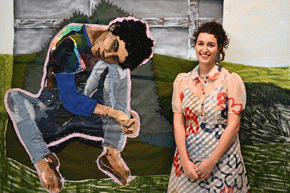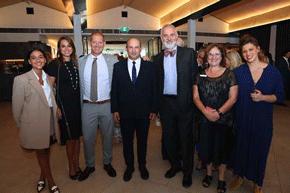Sh’mini Atzeret & Simchat Torah
Rabbi Raymond Apple writes on this week’s festivals.

Rabbi Raymond Apple
DAYS OF JOY
Sh’mini Atzeret and Simchat Torah, the two days tacked onto Sukkot, share the Sukkot sub-title of “Z’man Simchatenu”, Our Time of Joy.
It’s not hard to understand why Simchat Torah is a day of joy, but Sh’mini Atzeret is rather different and solemn.
Its prayers for rain recognise that (in the northern hemisphere at least) the winter is around the corner with its colder temperatures and rainstorms. Without winter the year would be lopsided. Without rain, the world would suffer and starve.
The rain prayer was always taken seriously and the officiating cantor wore his High Holyday white robe.
In these circumstances how can we call the day “Z’man Simchatenu”?
Because rain is a precious joy, because God’s world is a thing of beauty, because we have the privilege of being alive to enjoy it.
USING THE SUKKAH ON SH’MINI ATZERET
There are seven days of Sukkot followed by the concluding festival of Sh’mini Atzeret.
In the Gemara, there is a debate about whether this last day belongs to Sukkot or is a festival on its own. If it is a separate festival one need not eat in the sukkah that day.
The Aruch LaNer thinks the issue has to do with whether one may add to the commands of the Torah. Hence eating in the sukkah on Sh’mini Atzeret might be to add to the Torah commands.
Rabbi Yochanan who says that one may not eat in the sukkah in the Diaspora that day says there are two options – eating in the sukkah and thus “adding” to the mitzvah – or not eating in the sukkah and thus possibly reducing the mitzvah of the sukkah.
Rabbi Yochanan preferred the second option since the possible transgression is not particularly definite or active.
A SIYYUM FOR SIMCHAT TORAH
The custom is to conclude the study of any religious book with a siyyum which celebrates the achievement and ponders the final section of the book.
This year (indeed it would be appropriate any year) let us celebrate the conclusion of the Five Books of Moses by means of a siyyum on the final verses of D’varim chapter 34.
– The chapter marks the end of the long career of Moses. The next book of Tanach opens with Joshua taking over the leadership. Why did Moses’ own sons not inherit the role? The Midrash explains that Joshua had earned the rank of leader by a lifetime of faithful service. The decision was made by God, showing that political leadership is not hereditary.
– How old was Moses when he died (verse 7)? 120, i.e. 10 x 12, perhaps because each decade of his life was dedicated to the 12 tribes.
– Why (verse 10) is Moses called a prophet? Not because he could predict future events but because he received the Divine message more clearly than anyone else and he conveyed it with passion.
– Why does verse 12 emphasise how strong Moses was? When the people disobeyed the Torah, Moses was mighty and courageous enough to smash the tablets of the covenant because he thought Israel did not deserve them.
– Why (verse 6) does nobody know where Moses is buried? To prevent it becoming a national shrine, and because, as the sages say in the Jerusalem Talmud, the righteous need no monument; their deeds are their memorial.
JEWISH AT NIGHT
Simchat Torah is a whole day but it is at night that the experience takes shape.
Its only rivals are Seder and Kol Nidrei night.
Kol Nidrei is awesome – not only because of the prayers but because it literally articulates the verse, “In the multitude of people the King is glorified” (Prov. 14:28).
Seder night is joyful – not only because of the food, the wine, the Haggadah and the songs but because we re-live our history and hopes.
The night-time invests all these occasions with unique excitement. And there are so many other wondrous evenings which between them supply the kaleidoscope of the Jewish year.
The whole story of Judaism begins at night: “Vay’hi erev vay’hi voker…” – “It was evening, then it was morning: one day”.
Every week has its Jewish night – Friday night: the time to re-connect with ourselves, our dear ones and friends, our identity, our tradition, our God.
Every festival is ushered in at night – not only Pesach and Yom Kippur, but Shavu’ot and Hoshana Rabbah with their all-night study; Sukkot, magical from the first evening; Simchat Torah with its proud Torah parade; Purim with the dramatic megillah, Tishah B’Av with the solemn Echah… Chanukah, becoming brighter with each evening.
There is an aura about evenings. The air is clearer. The pace has slowed down. It is a time for looking back on the day – and looking ahead to tomorrow.
Metaphorically the evening is also the time of hope, the darkness before the dawn. Even when night seems to have gone on too long, we know there will be a new day. We say with the Psalmist, “How long, O Lord? How long?” We want to know: why is the dawn taking so long?
This was our question in the days of Judah Maccabee when the enemy that imposed a long night on Judea could not prevent the inexorable birth of the new era.
It was our question during the centuries of Diaspora history when hostile regimes were constantly seeking to put us in our place (as lowly as possible) if not to destroy us completely. It was the question of the Holocaust generation.
Whenever we asked the question we found that if one can get through the night, there will always be a new day. We discovered that the evenings are the moment for hope, faith and destiny.
“Erev Tov” is not only a greeting: it is an affirmation of Judaism.









